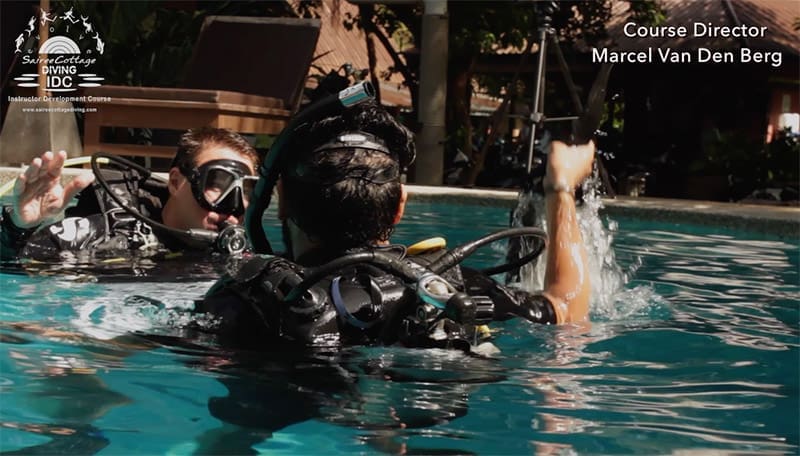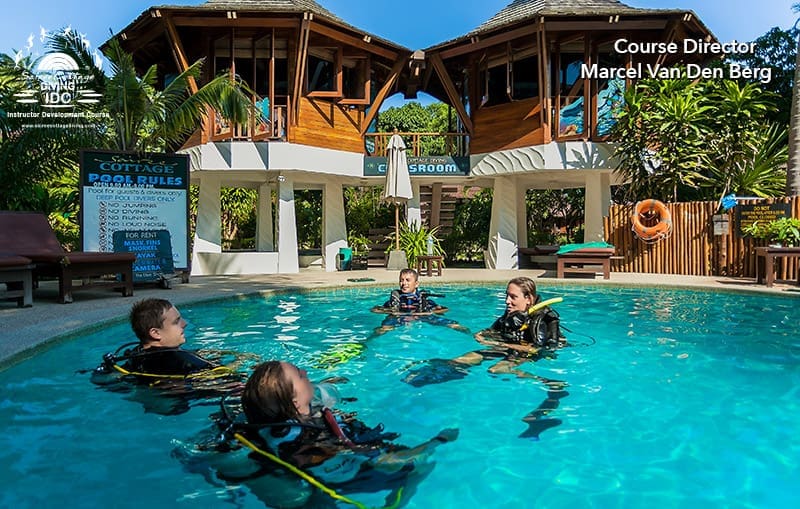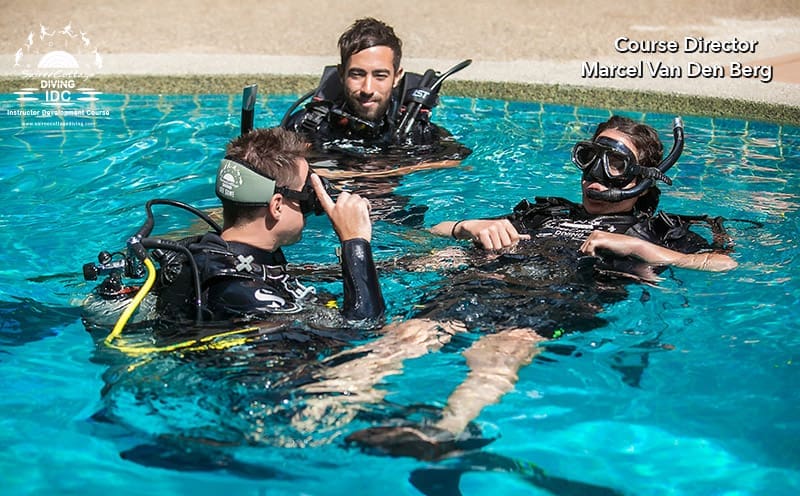The PADI Emergency Weight Belt Drop skill was added when PADI revised the Open Water Diver Course in 2013. Since then, I have had many Dive Instructors come to me to ask for advice on how to teach the PADI Emergency Weight Belt Drop skill. I hope that this article will help you to teach the PADI Emergency Weight Belt Drop skill both in real life and during the PADI Instructor Development Course (IDC).

It is important to understand that any PADI diving skill can be performed in slightly different ways depending on the style of the Diving Instructor. Here, I want to explain one way of performing it within PADI standards that is not only one of the safest options displaying a realistic performance, but also it’s aimed at getting you full scores (5.0) on any PADI IDC Course and the PADI Instructor Examination (IE).
Why is the Emergency Weight Belt Drop such an important PADI Skill?
I remember being part of a live update from PADI where they announced the new PADI Emergency Weight Belt Drop skill and a lot of Dive Instructors in the room did not even think the skill was important and it that it would be unnecessarily time consuming. This blew me away as PADI explained that an average of 85% of divers found after an accident still had their weight belts on. For this reason the PADI Emergency Weight Belt Drop skill is a very important skill to teach and can possibly be life-saving in a diver emergency.
Picking the best location for the PADI Emergency Weight Belt Drop skill in confined water
Confined Open Water means a swimming pool or an open water area with swimming pool like conditions. According to the PADI Instructor Manual you need to perform the PADI Emergency Weight Belt Drop skill in either Confined or Open Water and in water too deep in which to stand.
If you have the option I recommend choosing a pool for confined water so there will be no chance of hurting any aquatic life. I know many who disagree and say that confined open water or open water is best if you have a soft sandy bottom, plus in the pool there’s a chance of damaging the tiles. But there are ways to solve that and at least trying to minimize the chance of hitting a live creature hidden in the sand is a good thing to do.
If you have no choice, then of course you will have to find a suitable confined open water or open water destination. In this case, always try to make sure that all is clear underneath you to safely perform the PADI Emergency Weight Belt Drop skill.
How to not damage the bottom of the pool while performing the Emergency Weight Belt Drop skill
In almost every PADI meeting I joined since the introduction of this skill, there has been at least one PADI Dive Professional asking how to perform the Emergency Weight Belt Drop skill without damaging the pool. There are some easy solutions for this:
- Best option is to use soft weights / belt for this skill, as you can drop them without having to worry about damaging the pool. (This is a great option in general to protect your pool in any other situation as well).
- Have a Divemaster or any other assistant catch the falling weight belts before they hit the bottom of the pool.
- Use integrated weights instead of a weight belt as they are usually softer (if available).
- Place a soft (rubber) mat on the bottom before starting the Emergency Weight Belt Drop exercise.
- Use a new weight belt, with only half a kilo on it (still be careful and know there is still a small chance of damage).

There are more great ways to perform the Emergency Weight Belt Drop skill and not damage the bottom of the pool. If you know any then please share them in the comments below.
How to organise the PADI Emergency Weight Belt Drop skill in confined water or open water
Like I said before make sure that the area you choose to perform the PADI Emergency Weight Belt Drop skill is clear from aquatic life and other divers. Have your diving students lined up against the wall of the pool or in a straight line at a buoy line in the open water.
Have a certified assistant (PADI Divemaster or higher) watch over the students. Perform the PADI Emergency Weight Belt Drop skill demonstration and then afterwards perform the skill with one or two students at a time. During the PADI IDC I highly recommend to do this skill with one student at a time, but when you teach the PADI Emergency Weight Belt Drop skill in real life you can do it easily with 2 or even more students at the same time depending on your experience as a Diving Instructor, the capability of your students, environmental conditions, weight system used and other factors.
The Emergency Weight Belt Drop in confined water briefing
There are many different ways to brief the PADI Emergency Weight Belt Drop skill in confined water. During the PADI IDC and IE you need to mention a few points to get full marks:
Objective
Value
Description
Signals
Organization
You can find the Objective in the PADI Instructor manual in Section 3 of the Open Water Diver course under Dive Flexible Skills.

Objective:
Emergency Weight Drop – During any dive, in either confined or open water, at the surface in water too deep in which to stand, with a deflated BCD, have student divers use the weight system’s quick release system to pull clear and drop sufficient weight to become positively buoyant.
Value:
In the unlikely event you are in trouble at the surface, you can drop your weight belt / system to quickly establish more positive buoyancy.
Description:
Start by putting your regulator in your mouth. Then, very importantly, make sure there is no diver(s) and/or aquatic life below you. Then in a vertical position, start deflating your BCD and start kicking (swimming) upwards. Try to do slow, long and strong fin kicks to keep your chest above the surface. Once the BCD is completely deflated remove the weight belt by opening the quick release buckle with your right hand. Fully remove the weight belt and drop it. Lean back a bit to help with being less positively buoyant than normal to complete this skill.
Signals:
Deflate BCD, kicking, right hand, lean back, etc.
Organization:
We start in the deep end in a straight line next to each other. My Divemaster will be looking after you and I will start with a demonstration. After my demonstration I will come up to you one by one until we are all done.
Do you have any questions?
This is a great way to explain the briefing but the order is not very realistic. To make it more realistic I recommend to use this order:
Objective
Value
Organization
Description (with signals integrated)
Please integrate the signals by showing them during the description to make it even more realistic.
This is an example of a more realistic PADI Emergency Weight Belt Drop briefing for confined water both in real life and during the IDC and IE:
“Hi all, the next skill we will be doing is to perform an Emergency Weight Belt Drop, with deflated BCD in water which is too deep to stand in.
This is a great skill to learn because in the unlikely event you are in trouble at the surface, you can drop your weight belt / system to quickly establish a more positive buoyancy.
We will start in the deep end and in a straight line next to each other. My Divemaster will be looking after you and I will start with a demonstration. Please keep looking during my demo and afterwards I will ask you if you understood it. After my demonstration I will come up to you one by one until we are all done.
So how are we going to do the Emergency Weight Belt Drop skill? (now integrate a display of hand signals, while you are explaining)
First of all have your mask on your face and your regulator in. Then start deflating your BCD in a vertical position. Please start kicking your legs while deflating your BCD and make sure you are doing long strong kick strokes to keep your chest above the surface. Once the BCD is completely deflated, remove your weight system and drop it. Lean back and establish positive buoyancy.
Do you have any questions?”
Now this is a much more realistic order for the PADI Emergency Weight Belt Drop in confined water briefing.
Best way to demonstrate the CESA (Controlled Emergency Swimming Ascent) in confined water
Start the Emergency Weight Belt Drop skill by positioning yourself in front of the students and explain (by signalling) to them that you are about to demonstrate the Emergency Weight Belt Drop skill. Remind them to look at you throughout the full skill demonstration. First show them to check that the area below them is clear. Show them to keep their regulator in their mouth. Start kicking and ask them to look underwater to see how you kick your legs. Then start deflating the BCD slowly. Once deflated show the students how to remove the weight system with your right hand and how to establish positive buoyancy afterwards.
How to perform the PADI Emergency Weight Belt Drop) with your students in confined water
After you have completed the Emergency Weight Belt Drop demonstration, signal to the PADI Divemaster or Assistant Instructor to ask if they are ok, and that they should watch the students that you are not performing the skill with. Then take one OW/IDC student out of the line, place him or her a little in front of the line and signal to the student to start the Emergency Weight Belt Drop skill.

By standards you don’t have to hold onto the student – it depends on the situation or student if you choose to or not. Especially in confined water holding on can be a bit intimidating for Open Water Course students, but you are free to do what you think is the best and safest option for the Emergency Weight Belt Drop skill.
If a problem occurs during the Emergency Weight Belt Drop, then stop the student, correct the problem and continue or restart the skill from the starting point (depending on the problem). Once the skill is completed perfectly, give them some positive reinforcement like a handshake or high five, remind them one more time about the problem so they don’t forget, then finish it with another happy handshake or high five (students love this). Communicate again with the Divemaster or Assistant Instructor to now watch the student who just performed the skill and the other students who are not performing the skill. Then start the Emergency Weight Belt Drop again with the next student until everyone is done.
Problems that can occur during the PADI Emergency Weight Belt Drop skill in confined water
Not kicking the legs – This problem needs to be spotted quickly to make sure the student’s chin does not go below the water. If their face does submerge but they have the regulator in their mouth and you are quick enough, it should still result in a good score if the Emergency Weight Belt Drop skill is restarted. To be honest if you are too slow and the mouth and nose goes under water and there is no regulator or snorkel in the student’s mouth, personally, I like to score it a 1.0. So my advice is to be on the ball with this problem.
(To clarify, if you respond slowly to this problem but the student keeps their regulator in their mouth it will result in a 3.0 during the PADI IDC or IE – and it will result in a 1.0 if the same thing happens with no mouth piece in the mouth)

Not deflating the BCD – This problem should be easy to catch as it is the first problem that may occur in the Emergency Weight Belt Drop skill. However, I have seen quite a few IDC candidates not spotting this problem as they are nervous or the skill is quite new for them to teach.
(If you don’t catch this problem on the PADI IDC or IE it will result in a score of 1.0 because of a violation of standards. That means you failed the skill presentation)
Inflating the BCD – This is very easy to catch as it makes a lot of noise and bubbles.
(If you don’t catch this problem on the PADI IDC or IE it will result in a score of 1.0 because of a violation of standards and that means you failed the skill presentation)
No mouth piece in – Before the student starts, make sure you look at the mouth and check if they have the second stage of the regulator in. A snorkel is also fine, but the second stage will be much more effective and realistic In real life the person surfacing in an emergency will most likely have their regulator in their mouth and not their snorkel.
(If you don’t catch this problem on the PADI IDC or IE it will result into a score of 2.0 or 1.0 if they submerged the mouth and nose without the mouthpiece in)
Not being able to remove the weight system – This problem is super easy to catch and quite common in real life.
(If you don’t catch this problem on the PADI IDC or IE it will result into a score of 1.0, but you will catch this problem very easily, so don’t worry)
This trick is to just take it slow, monitor everything during the skill and you should be fine.
Finish the Emergency Weight Belt Drop skill with a great debrief
Same as in the initial briefing, you can debrief your students on the surface at the deep end or in the shallow area of the pool or confined water or even back on land. In real life there are different versions of a good debrief, but a great one to use is the debrief from the PADI Instructor Development Course. In the IDC debrief you have to mention the following to get full points:
Positive reinforcement
Problems that occurred
Solutions to those problems
Reinstate the objective
Remember the value
To make it sound as nice and realistic as possible I recommend you say this:
“All of you, great job in completing the Emergency Weight Belt Drop (Reinstate the objective) – I especially liked the way that everyone kept their regulators in their mouths during the skill. Well done! (Positive reinforcements)
However, I did see that someone didn’t kick their legs (Problem that occurred), remember to kick your legs slowly but strongly throughout the skill (Solution to the problem). I also saw someone using their left hand to take the weight belt off (Problem that occurred), just remember it is much easier to use the right hand as most weight systems use a righthand quick release mechanism.
But, really great job all and remember that this skill is an amazing skill to master in the unlikely event that you are ever in trouble at the surface, knowing you can drop your weight belt / system to quickly establish more positive buoyancy.
Again great job all and do you have any questions?”
Conclusion
I hope that these teaching tips to conduct the PADI Emergency Weight Belt Drop in confined and open water will help you teach this skill in real life and if you follow everything in this article you will get full points for the PADI Emergency Weight Belt Drop skill in confined water during the PADI IDC and the PADI IE.
Of course there are many ways to teach the PADI Emergency Weight Belt Drop in confined water according to PADI standards – please use your own style if you prefer, but this is one way of performing the Emergency Weight Belt Drop skill correctly. If you have more tips then please share them in the comments below and don’t forget to “Like” this article and share it with as many people as possible through your social media.
If you would also like to become a PADI Diving Instructor or want to recommend a friend to do so, then please contact us and join our PADI IDC, MSDT or Dive Instructor Internship course.

Marcel van den Berg
PADI Platinum Course Director
Sairee Cottage Diving
Koh Tao, Thailand

